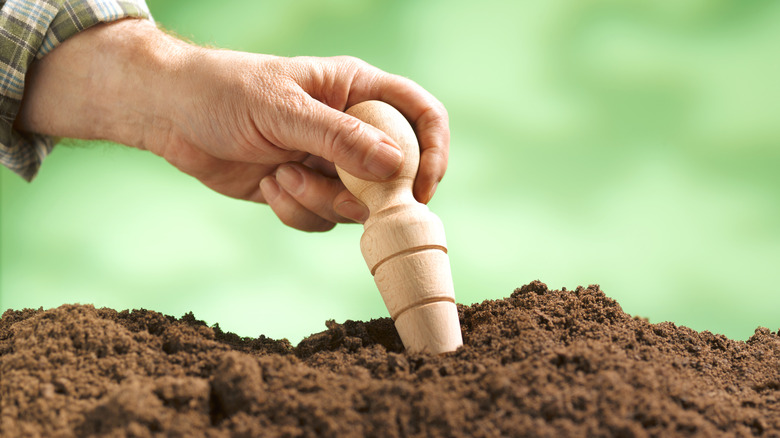Don't Throw Out Scrap Wood Without Trying This DIY For Potting Plants
If you're someone who's constantly potting up seedlings or plants, you know how tedious it can be to transfer them from smaller pots to larger ones. It takes time, precision, and a lot of patience. But with just a small scrap piece of wood, you can streamline the whole process into something fast, easy, and oddly satisfying. Instead of pressing each plant into a hole in the soil and hoping it fits, this scrap-wood trick lets you make a perfectly sized indentation every time.
All you need is a chunk of leftover wood and a carving knife or something else to whittle the wood with. Shape it into a 2-inch or 4-inch plug (the most common starter pot sizes) and press it into the soil before transplanting. This creates a snug little pocket for your seedling to slide into without disturbing the roots or spilling any soil. The best part is it's totally free if you've got wood lying around from another DIY project.
This hack is perfect for gardeners who want to save time, reduce mess, and make the entire planting process a little more efficient. Plus, there's something satisfying about repurposing materials instead of tossing them in the trash. This clever DIY is one gardening hack that will give you an instant green thumb.
How to make your own potting-up tool from scrap wood
To try this seed starting hack, first figure out what size plant you need to pot up most frequently, such as a 2-inch seedling plug. Then carve your wood into a dowel that roughly matches the size and shape of that pot. Once it's shaped, you'll be able to press the wooden tool into the center of any new pots filled with soil. It'll create a perfectly formed indentation that matches the size of the 2-inch plant you're transferring so it can drop right in place.
This not only saves time and effort but also keeps root systems intact, which reduces the stress on the plant. The fit is snug and custom every time, with no guesswork and no messy soil spillage. You can even make multiple versions for different pot sizes from broken shovel handles or wooden chair legs, so you can easily repot all your favorite plants.
If you want to customize it further, you can sand the edges smooth for a professional finish or label your tools by pot size to keep things organized. This also works great with biodegradable pots or seed-starting trays if you're prepping for a big planting day. Whether you're repotting succulents, herbs, or your latest tomato starts, this is a simple, sustainable way to upgrade your gardening game (and it costs next to nothing).
An ancient tool: meet the dibble
Believe it or not, this clever DIY trick has roots. The wooden tool you just made is actually a modern spin on a centuries-old gardening essential called the dibble (also known as a dibber or dibbler). This simple but effective implement has been used for many years to help gardeners plant faster and more efficiently, especially when working by hand.
The earliest versions of the dibble date back to ancient times. Gardeners would use a pointed stick or wooden stake to poke holes into the soil for seeds or seedlings. The shape was simple: a tapered end that allowed for consistent depth and spacing. As farming techniques evolved, so did the dibble. For hundreds of years, gardeners and farmers have used dibbles made from wood or metal to plant rows of crops in record time.
The modern version can be handheld, long-handled, or even mechanized, but the core concept remains unchanged. It's all about creating the perfect hole with less effort, and your carved scrap wood tool does just that. Sometimes old-school gardening tricks are still the best for the job, and if you've got scrap wood sitting in your shed, you might already have everything you need to make your own piece of gardening history.

